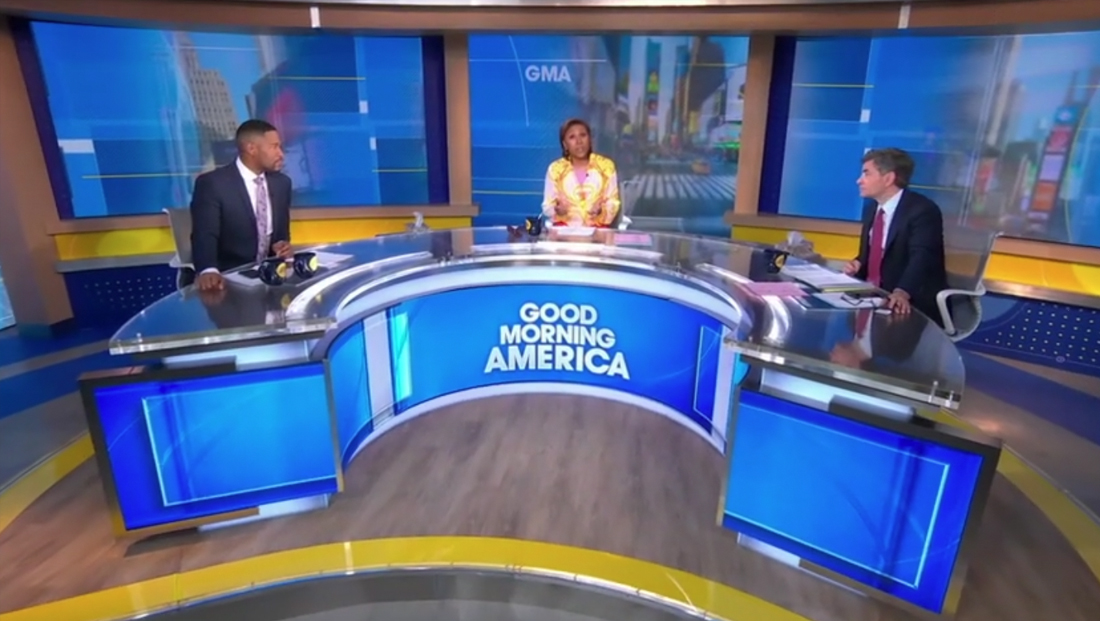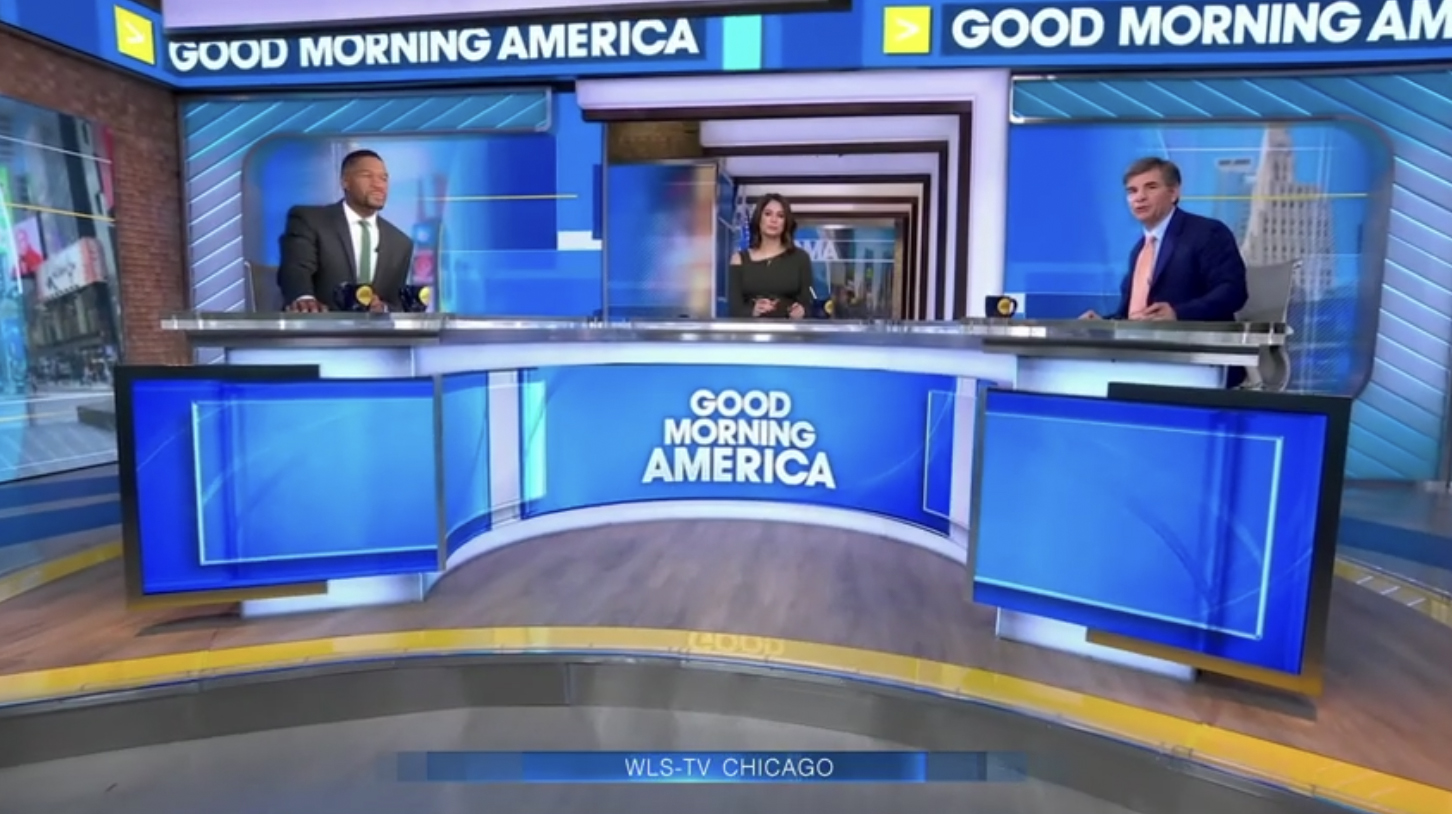‘GMA’ set gets studio update as bigger changes are in the works

Subscribe to NCS for the latest news, project case studies and product announcements in broadcast technology, creative design and engineering delivered to your inbox.
ABC News‘ “Good Morning America” unveiled some set updates March 14, 2022 in its Times Square studio’s anchor area that are part of a broader studio update.
Meanwhile, the upstairs windows of the facility have been covered as work begins to revamp that space. Additional changes to the first level appear to be in the works as well.
The initial round of changes mainly include a new curved wall with three segments of seamless LED behind home base.
This design significantly simplifies the walls behind the desk and removes multiple prominent visual elements introduced in the space back in April 2019.
Gone are the camera left and camera right surrounds featuring metal framing and diagonal reveal lines. The hallway element camera center that features prominent L-shaped lightboxes and, on the left side, a band of LED that wrapped around the corner that serves as the background behind whoever sits in the center of the studio, typically Robin Roberts.
That hallway area, which resembled a real passageway, was built due to the space being dotted with structural columns that cannot be removed and also featured a circular LED panel with edge lit glass hash marks that was never prominently used.
This entire layout was also notably slightly asymmetrical.

A September 2018 segment on ‘Good Morning America’ that used the small, alcove like passageways and spaces in ABC’s Times Square studios to showcase on set graphics captured by a handheld camera.
Prior to the 2019 update, the space had a series of maze like passages and small alcoves that served as venues for standups, weather and “video on video” sequences that often involved a floating camera making multiple on air moves.
The new design significantly simplifies the space’s look while also adding more digital canvas space in the form of video walls.
Roberts now sits in front of a segment of LED that’s flanked by two wood toned columns similar to the distinctive square patterned walls introduced back in 2019 and is narrower than the larger ones installed on either side and framed out with dark blue printed graphics that appear black in wide views.
The camera left and right walls boast blue and yellow knee walls created using additional printed graphics, while the entire wall is capped off with a metallic curved header.

The new wall has been set up directly in front of the old set’s primary background, with some of those elements still visible in wide shots.
Meanwhile, the LED ribbon above the old primary anchor area remains but the new wall mostly obscures a good part of it.

How the set looked Friday, March 11, 2022 prior to bringing in the new wall.
The video walls behind the anchors continue to showcase mostly blue collages with blurred Times Square imagery.

Most of the rest of the studio appears to be unchanged, including the large video wall installed camera left that’s used for weather, standups and debriefs.
The myriad of other LED panels, many in the form of columns, remain throughout the space and continues to be used prominently on air through “video on video” and “walk and wander” floating camera setups as well as for less formal interview segments.

For at least some of Roberts’ one shots, she was framed with one of the wood columns just over one shoulder, with portions of both the center and camera left video walls showing up behind her.
“GMA Weekend” shifted production to Studio TV3 at ABC News Headquarters in Lincoln Square in December 2021, using still imagery of the Times Square set as virtual set extensions on the space’s plentiful video walls.
TV3 shares some visual elements with the “GMA” space in Times Square, most prominently the repeating L-shaped lightboxes.
The space continues to use the larger horseshoe-shaped desk that was installed in February 2021 to help with social distancing between talent.
Prior to that, the show simply moved the camera left and camera right anchors more toward the outer edge of the desk, but this also meant Michael Strahan and George Stephanopoulos, who usually sit in these positions, weren’t able to keep their legs hidden behind the desk. At the time, it seemed a minor inconvenience, but the network ultimately replaced the desk entirely, following the practice of many other broadcasters during the coronavirus pandemic.

Later on March 14, “GMA3: What You Need to Know” also originated from the first floor set. The show normally uses the second floor space, but that space is in the process of receiving a major renovation, forcing co-anchors Amy Robach and T.J. Holmes downstairs for the time being.
The video walls and anchor desk were all fed version of the show’s cheerful red, orange, yellow and blue graphics, as were the LED ribbons and other video panels that appeared on camera.
The second floor of ABC’s Times Square studios was last overhauled in 2016 and would also be home to the network’s 2016 election coverage.
The new design was aimed at making it possible to bring a studio audience in to interact with hosts and was primarily used later in the two hour show’s run. It was also home of the talk show style “GMA Day” that would rebranded as “Strahan and Sara” and “Strahan, Sarah and Keke” that took the place of “The Chew.”
During the start of the coronavirus pandemic in 2020, studio audiences were discontinued and the show was eventually put on hiatus, with the network opting to fill the hour with “Pandemic: What You Need to Know.” In June of 2020, the hour was rebranded as “GMA3: What You Need to Know.” It continued to air without a studio audience.
In September 2020, the show got new graphics as well as a set upgrade.
ABC first moved into the Times Square facility in 1999 and “GMA” had multiple sets on the second floor, all of which have since been removed.
The first floor studio space, roughly in the same area as the modern day one, was outfitted with custom engineered windows that could be moved out of the way to create an open air studio of sorts.
At that time, the studio was a smaller footprint and was designed to look like a subway station and was primarily used for weather and feature segments.
Over the years, ABC took over nearby retail space as leases expired, expanding its ground floor presence. At one time, one of these expansions was used to create the “Social Square,” a social media driven area that was eventually discontinued.
Subscribe to NCS for the latest news, project case studies and product announcements in broadcast technology, creative design and engineering delivered to your inbox.






tags
ABC, ABC News, ABC Studios NYC, GMA, Good Morning America, Studio TV3, times square
categories
Broadcast Design, Broadcast Industry News, Heroes, Network Morning Shows, Networks, News Set Design, Set Design